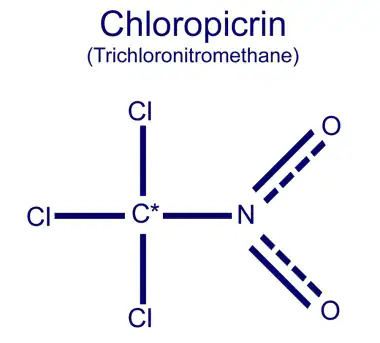Appearance colorless liquid Boiling point 112 °C Melting point -69 °C | Formula CCl3NO2 Density 1.69 g/cm³ | |
 | ||
Chloropicrin, also known as PS and nitrochloroform, is a chemical compound currently used as a broad-spectrum antimicrobial, fungicide, herbicide, insecticide, and nematicide. Its chemical structural formula is Cl3CNO2.
Contents

Discovery
Chloropicrin was discovered in 1848 by Scottish chemist John Stenhouse. He prepared it by the reaction of a chlorinating agent with picric acid:
HOC6H2(NO2)3 + 11 NaOCl → 3 Cl3CNO2 + 3 Na2CO3 + 3 NaOH + 2 NaClBecause of the precursor used, Stenhouse named the compound chloropicrin, although the two compounds are structurally dissimilar.
Properties

Chloropicrin’s chemical formula is CCl3NO2 and its molecular weight is 164.38 grams/mole. Pure chloropicrin is a colorless liquid, with a boiling point of 112 °C. Chloropicrin is sparingly soluble in water with solubility of 2000 mg/L at 25 °C. It is volatile, with a vapor pressure of 23.2 millimeters of mercury (mmHg) at 25 °C; the corresponding Henry’s Law Constant is 0.00251 atmosphere-cubic meter per mole. The octanol-water partition coefficient (Kow) of chloropicrin is estimated to be 269. Its soil adsorption coefficient (Koc; normalized to soil organic matter content) is 25 cm3/g.
Use

Chloropicrin was manufactured for use as poison gas in World War I. In agriculture, chloropicrin is injected into soil prior to planting a crop in order to fumigate soil. Chloropicrin affects a broad spectrum of fungi, microbes, insects. It is commonly used as a stand alone treatment or in combination / co-formulation with methyl bromide and 1,3-Dichloropropene. Chloropicrin is used as an indicator and repellent while fumigating residences for insects with sulfuryl fluoride which is an odorless gas.
Safety
At the national level, chloropicrin is regulated by the United States Environmental Protection Agency as a restricted use pesticide. Because of its toxicity and carcinogenicity, distribution and use of chloropicrin is available only to licensed professionals and specially certified growers who are trained in its proper and safe use. In the US, occupational exposure limits have been set at 0.1 ppm over an eight-hour time-weighted average.
Agriculture
In 2008 the US EPA re-approved chloropicrin as safe for use in agricultural settings, stating that treatments "can provide benefits to both food consumers and growers. For consumers, it means more fresh fruits and vegetables can be cheaply produced domestically year-round because several severe pest problems can be efficiently controlled." To ensure chloropicrin is used safely, the EPA requires a strict set of protections for handlers, workers, and persons living and working in and around farmland during treatments. EPA protections were increased in both 2011 and 2012, reducing fumigant exposures and significantly improving safety. Protections include the training of certified applicators supervising pesticide application, the use of buffer zones, posting before and during pesticide application, fumigant management plans, and compliance assistance and assurance measures.
California
In California experience with acute effects of chloropicrin when used as a soil fumigant for strawberries and other crops led to the release of regulations in January 2015 creating buffer zones and other precautions to minimize exposure of farm workers, neighbors, and passersby.
High Concentrations
Chloropicrin is harmful to humans. It can be absorbed systemically through inhalation, ingestion, and the skin. At high concentrations it is severely irritating to the lungs, eyes, and skin. In World War I German forces used concentrated chloropicrin against Allied forces as a tear gas. While not as lethal as other chemical weapons, it caused vomiting and forced Allied soldiers to remove their masks to vomit, exposing them to other, more toxic chemical gases used as weapons during the war.
Preparation
Chloropicrin is manufactured by the reaction of nitromethane with sodium hypochlorite:
H3CNO2 + 3 NaOCl → Cl3CNO2 + 3 NaOH